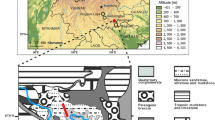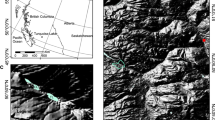Abstract
The longest vertical profile from the western basin of Taihu Lake ever taken was nearly 4 m (396 cm) in length and represented a time period of over 14 000 years. The core was analyzed for the following proxies, magnetic susceptibility, organic carbon isotope, total organic carbon, total nitrogen, total pigments, saturated hydrocarbons, carbon 14, thermolytic hydrogen (the hydrogen index, HI) and foraminifera. Results from the west Taihu lake core indicate that ca. 14 300–13 400 a B.P., the lake was relatively shallow and the climate was likely to have been quite arid. From 13 400 to 12 400 a B.P., the environment became less arid and the depth of the water in Lake Taihu increased. Marine incursions occurred during this period as indicated by the presence of numerous marine foraminifera. From ca. 12 400 to 10 900 a B.P., the climate became wetter, warmer and more variable. A cold dry period occurred around ca. 11 500 a B.P., causing the lake to become more shallow. From 10 900 to 10 000 a B.P., a warm and wet period reasserted itself and water depth again increased. A cold dry period reoccurred from 10 000 to 9500 a B. P. From 9500 to 7200 a B.P., the climate was quite variable. By 7200–5700 a B.P., the climate again turned warmer and wetter. Some of the major sediment proxies used in this study changed dramatically at ca. 5050 a B.P., reflecting changes in material source and a probable interruption of sedimentation. The modern environment (4900 aB.P.-present) was characterized by a well oxidized sediment layer and thriving algae. The lake is presently very eutrophic and is characterized by cyanobacteria, primarily Microcystis aeruginosa, the dominant primary producer in the lake. This is the first study to use a variety of organic geochemical proxies to infer paleoenvironmental changes in Taihu Lake.
Similar content being viewed by others
References
Barnes, M. A., 1978. Organic compounds in lake sediments. In Lerman, A. (ed.), Lake-Chemistry, Geology, Physics. Springer, N.Y: 127–152.
Chang, Y. B. &; Liu Jinglin, 1996. The origin and evolution of Taihu Lake: An 11 000-year journey. Acta Palaeontologica Sinica 35 (2): 129–135 (in Chinese).
Deines, P., 1980. The isotopic composition of reduced organic carbon. In Fritz, P. &; J. C. Fontes (eds), Handbook of Environmental Isotope Geochemistry. Elsevier, Amsterdam: 219–406.
Dickman, M., P. Peimin &; Z. Changsu, 2000. Some consquences of hypereutrophication and wind induced mixing to the limnology of Tai lake in Eastern China. Internat. Verin. Limnol. 27: (In press)
Kra, R., 1986. Standardizing procedures for collecting, submitting, recording and reporting radiocarbon samples, radiocarbon 28 (2A): 765–775.
Qian, Junlong, Zhang Liandi &; Le Melin, 1990. The determination of total nitrogen and total phosphorus by digestion of persulphate. Soil 22 (5): 258–262 (in Chinese).
Qu, Wenchuan, M. Dickman, Wang Sumin &; Wu Ruijin, 1998. Lake typology based on the use of lake sediment alkanes in the east and west basins of Taihu Lake, China. Hydrobiologia 364: 219–223.
Qu, Wenchuan, M. Dickman, Wang Sumin &; Wu Ruijin, 1999. Evidence for an aquatic origin of ketones found in Taihu Lake sediments. Hydrobiologia 397: 149–154.
Qu, Wenchuan, Wu Ruijin, Wang Sumin &; Zhang Zhengke, 2000. Sedimentary pigment and its environmental signification of East Yuyanhai in Inner Mongolia since the past 2600 years. Acta Sedimentologicica Sinica. 18 (1): 14–17.
Remane, A., 1934. The Brackish Water Fauna. Verh. Dt. Zool. Ges. 36: 34–74.
Schelske, C. L. &; D. A. Hodell, 1995. Using carbon isotopes of bulk sedimentary organic matter to reconstruct the history of nutrient loading and eutrophication in Lake Erie. Limnol. Oceanog. 40 (5): 918–929.
Shen, Ji, Wu Ruijin &; An Zhisheng, 1998. Characters of Organic ? 13C and Paleoenvironment in the Section of Babusu Lake. J. Lake Sci. 10 (3): 8–12.
Shi, Shaohua, 1993. The impact of environmental changes of Holocene megathermal on the Neolithic culture in Taihu Lake area. J. Lake Sci. 5 (2): 136–143 (in Chinese).
Shi, Yafeng, 1994. Climate and environments of the Holocene Megathermal Maximum in China. Science in China (B) 37 (4): 481–493.
Sun, Shuncai &; Huang Yiping, 1993. Taihu Lake. Ocean Press, Beijing: 1–6 (in Chinese).
Swain, B., 1985. Measurement and interpretation of sedimentary pigments. Freshwat. Biol. 15: 53–75.
Talbot, M. &; D. A. Livingstone. 1989. Hydrogen index and carbon isotopes of lacustrine organic matter as lake level indicators. Palaeogeography, Palaeoclimatology, Palaeoecology 70: 121–137.
Wang, Jian, Wang Yongjian, Liu Jingling &; Y. B. William, 1996. Evolutiuon of sedimentary environment in taihu Lake during the past 16 000 years. Acta Palaeontologica Sinica. 35 (2): 213–223.
Wang, Sumin &; Yang Xiangdong, 1996. The relationship of environmental changes and monsoon characters in the past 15 Ka from Gucheng Lake. Science in China. 26 (2): 137–141.
Xu, Xuemin, Y. B. William &; Liu Jinlin, 1996. Vegetation and climatic changes of the last 11 000 years in Taihu area. Acta Palaeontologica Sinica. 35(2): 175–185.
Xue, Bin, Qu Wenchuan, Wu Yanhong Wang Sumin &; Wu Ruijin, 1998. Sedimentological Record of Paleoenvironment of Taihu Lake in Late-Glacial to Holocene. J. Lake Sci. 10 (2): 30–36.
Yu, Lizhong, F. Oldfield, Wu Yusheu, Zhang Sufu &; Xiao Jiayi, 1990. Paleoenvironmental implication of magnetic measurements on sediment core from Kunming Basin, Southwest China. J. Paleolimnol. 3: 45–111.
Yu, Tianren &; Wang Zhenquan, 1980. Soil Analytical Chemistry. Beijing: Science Press. 15–17 (in Chinese).
Zhang, Pinzhong, Wang Xianbin, Chen Jianfa &; Wang Sumin, 1995. The composition of lacustrine organic hydrogen index and carbon isotope. Chinese Science Bulletin. 40 (18): 1682–1685 (in Chinese).
Zheng, Changsu, M. Dickman, Han Xiaozhong &; Pu Peimin, 1990. Palaeolimnology, history and origin of Tai Lake. China Earth Sciences 1: 267–281.
Author information
Authors and Affiliations
Rights and permissions
About this article
Cite this article
Qu, W., Xue, B., Dickman, M.D. et al. A 14 000-year record of paleoenvironmental change in the western basin of China's third largest lake, Lake Taihu. Hydrobiologia 432, 113–120 (2000). https://doi.org/10.1023/A:1004079220926
Issue Date:
DOI: https://doi.org/10.1023/A:1004079220926




